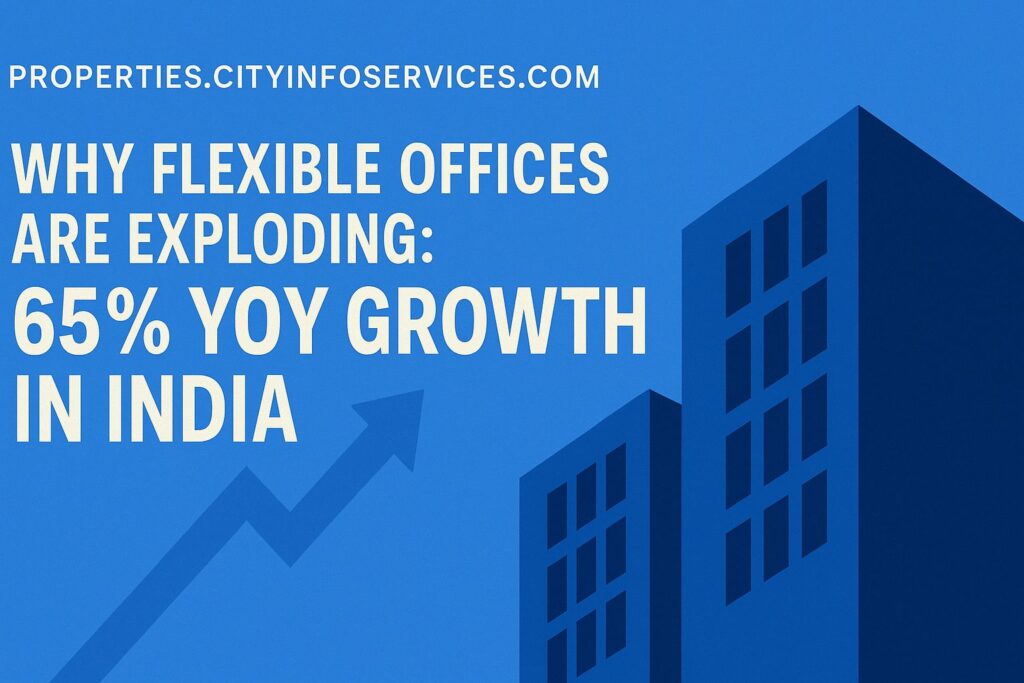
India’s office real estate market is undergoing a radical transformation—and at the heart of it is the meteoric rise of flexible offices. With a staggering 65% year-on-year growth, the demand for flex spaces in India has surpassed all expectations, signaling a major shift in how businesses view their workplace strategy.
As companies navigate hybrid models, cost optimization, and the need for agility, coworking and flexible workspace solutions have emerged as the clear winners. Once seen as niche or startup-only, these spaces are now being adopted by enterprises, global corporations, and even government-backed innovation hubs.
But what’s driving this growth, and more importantly, how should Indian CEOs, CFOs, and commercial real estate planners respond?
The Numbers Tell the Story: Why Flex Is Booming
According to a recent report by CBRE, flexible office stock in India has reached nearly 60 million square feet across major cities, led by Bangalore, Hyderabad, Pune, and Delhi-NCR. The report highlights a 65% YoY growth in transaction volumes in the flex segment during FY2023–24, making it one of the fastest-growing formats in the commercial real estate market.
Notably, enterprise demand accounted for a significant portion of this expansion, revealing that coworking is no longer just a freelancer’s domain, but a strategic corporate solution.
What’s Fueling the Demand for Flex Spaces in India?
1. Hybrid Work Is Here to Stay
COVID-19 catalyzed a rethink of the traditional office. As companies transitioned to remote models, many found that permanent large-format leases no longer matched their operational needs. Even post-pandemic, hybrid work has remained popular, leading firms to downsize fixed office footprints and invest in flexible office spaces that can scale up or down.
2. Cost Control and Financial Agility
In an inflationary environment, CFOs are seeking ways to reduce fixed overheads. Long-term leases, lock-in periods, and high capital expenditure are being traded for the flexibility of pay-as-you-go models. Flexible offices offer transparent pricing, bundled services, and zero upfront fit-out costs, making them ideal for leaner budgeting.
3. Access to Prime Locations Without the Premium
Many coworking operators offer plug-and-play access to Grade A buildings in central business districts (CBDs). For startups and even MNCs expanding into tier-1 or tier-2 cities, this is a cost-effective way to build presence in high-value zones without the long-term commitment.
4. Demand from Tier-2 and Tier-3 Cities
With remote hiring and talent mobility increasing, flex spaces in India are spreading beyond metro cities. Locations like Kochi, Jaipur, Ahmedabad, and Indore are seeing increased activity, driven by both local startups and enterprise satellite teams.
5. Workplace Experience and Amenities
Modern coworking spaces now offer premium services, concierge desks, event zones, cafes, wellness programs, and community-building activities, creating an ecosystem that promotes productivity and collaboration. This appeals to both millennials and Gen Z, who value experience alongside employment.
The Role of Flex Offices in Enterprise Strategy
Far from being just an operational convenience, flexible offices are now embedded in long-term business and real estate strategies. Here’s how leading companies in India are integrating them:
- Decentralized workplace models: Setting up multiple small offices closer to talent clusters instead of maintaining one large HQ.
- Project-based deployment: Renting flex spaces for specific teams or temporary projects in client-facing locations.
- Business continuity planning: Using coworking as backup sites for disaster recovery or overflow scenarios.
- Talent retention: Offering employees autonomy in choosing where they work, enhancing engagement, and reducing attrition.
Workplace Trends Driving Future Growth
As the nature of work continues to evolve, the demand for flex spaces in India is poised for sustained momentum. The shift is strategic, driven by long-term changes in workforce behavior, sustainability goals, and enterprise risk management. Several emerging trends are accelerating this transformation:
Core + Flex Strategy
More companies are adopting a “core + flex” real estate model, retaining a central office for core functions and supplementing it with coworking spaces across cities. This approach offers the best of both worlds: operational stability with built-in flexibility. It’s especially valuable for firms managing hybrid workforces or expanding into new markets with minimal risk and overhead.
Sustainability and Green Offices
Sustainability has become a boardroom priority, especially as ESG disclosures gain traction in India. Flex space providers are responding by investing in green-certified buildings, energy-efficient utilities, and digital environmental monitoring systems. By choosing flexible offices that meet LEED or IGBC standards, companies can align their workplace strategy with broader sustainability and compliance goals.
Tech-Enabled Workspaces
The future of work is digital, and flex spaces are increasingly becoming hubs of smart infrastructure. From AI-powered access control and occupancy sensors to IoT-based air quality monitoring and energy optimization tools, tech-enabled coworking environments are driving both employee well-being and data-driven performance.
Industry-Specific Coworking
A notable shift is the rise of vertical-focused coworking spaces. Fintech clusters, healthcare innovation hubs, legal coworking suites, and media labs are emerging as tailored environments for niche industries. These sector-aligned flex offices not only provide specialized infrastructure but also facilitate regulatory readiness, curated networking, and ecosystem collaboration, something generic offices often cannot match.
A Local Expert’s Perspective: Cityinfo Services
As one of India’s leading commercial real estate advisory firms, Cityinfo Services has witnessed this flex revolution first-hand. The company supports businesses across the country in identifying, evaluating, and transitioning into flex spaces that align with their operational and strategic needs.
With a deep understanding of micro-market dynamics, occupancy trends, and tenant preferences, Cityinfo acts as a trusted partner in helping Indian businesses unlock the full potential of coworking and flexible workspace models, from custom negotiations to location strategy and long-term planning.
Challenges to Watch For
While the upside of flex offices is clear, there are still considerations businesses must factor in:
- Data security: Shared spaces may pose risks for companies handling sensitive data or intellectual property.
- Brand identity: Maintaining a strong brand presence in a shared office requires custom signage, digital branding, and design inputs.
- Long-term availability: In high-demand zones, securing dedicated flex seats or private suites may require early commitment.
Working with experienced real estate consultants, such as Cityinfo Services, can help mitigate these concerns through location vetting, legal review, and operator performance benchmarking.
Conclusion
While the rise of flexible offices offers clear advantages, from agility and cost savings to faster market expansion, businesses must approach adoption strategically. Factors like data security, brand representation, and the right location mix play a critical role in making flex workspaces a long-term success rather than a temporary fix. In today’s environment, real estate decisions are no longer just operational; they’re deeply strategic.
With expert guidance from partners like Cityinfo Services, companies can navigate the flex space landscape confidently. By leveraging data-backed insights, market intelligence, and tailored workspace strategies, businesses in India can future-proof their operations and respond to change with speed and precision.



